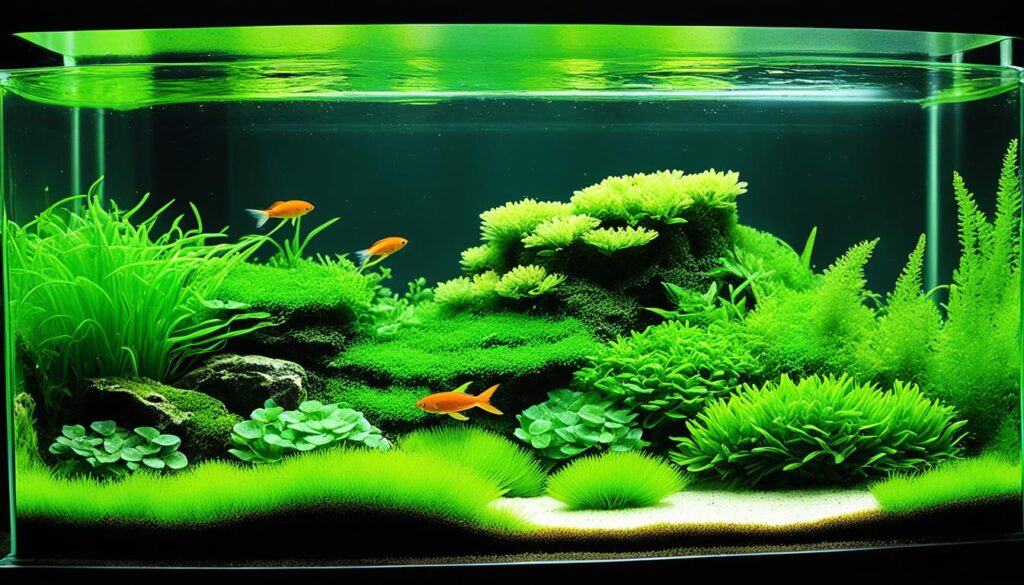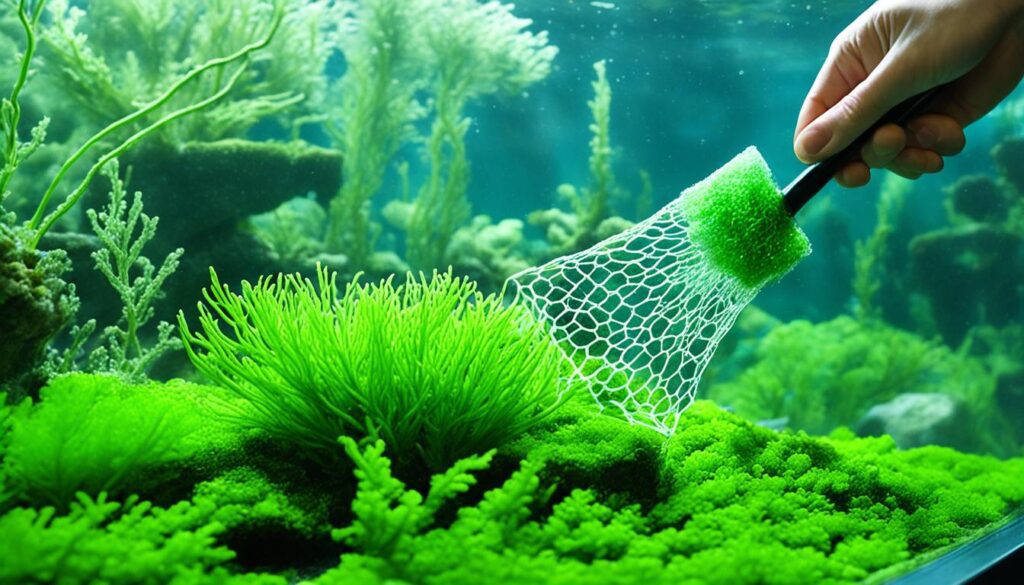As an aquarium hobbyist, I’ve seen a lot of talk about fuzz algae prevention. This topic has grabbed over 5K views, showing it’s a big deal for aquarium lovers. The online forums are buzzing with advice. 13 replies from 6 people recently tackled how to handle this issue, highlighting the need for aquarium maintenance and a well-balanced aquatic ecosystem.
It’s all about finding the right balance for algae control. Using fertilizers like APT 2 and APT root tabs works for some, aiming to keep nitrates within 5-10ppm. Also, keeping water clean is crucial, with many suggesting changes of 30% to 50% each week.
Less light, around 6-8 hours daily, has also made a big difference, going against the old 16-hour day. Cutting back on fertilizers, particularly in low-light tanks, helps prevent algae from outgrowing slow-moving plants.
Getting rid of these green tufts remains tough, even with CO2, easy carbo, and frequent water changes. Some look to technology, like programmable Hygger lights, for help. Adding plants like Hornwort can absorb nutrients and combat fuzz algae before it starts.
Whether your tank is new or old, paying attention is crucial. Adding algae eaters like shrimp or certain fish can help naturally. The key is consistent care, from how much you feed to water changes and checking nutrient levels, to keep your tank clear of algae.
So, there’s a summary of tips from fellow tank lovers on keeping aquariums clean and healthy. It’s valuable info for beginners and a good reminder for the experienced on maintaining balance in our mini water worlds.
Understanding Fuzz Algae in Freshwater Aquariums

Many aquarists struggle with keeping their aquariums healthy and visually appealing. A common issue is managing fuzz algae. This algae is not just unsightly; it suggests bigger problems, like poor aquarium plant health. To keep plants growing well and the aquarium balanced, knowing about fuzz algae is key.
Defining Fuzz Algae and Its Characteristics
Fuzz algae looks like short, fuzzy, green threads on the glass, ground, and plants. It’s a sign of stress or imbalance in the water, especially in new tanks. Knowing how to spot fuzz algae early can help you act fast. This keeps your aquarium plants healthier.
Distinguishing Between Fuzz Algae and Hair Algae
Fuzz and hair algae are both green strands, but they grow differently. Fuzz algae forms a soft green layer. Hair algae, however, grows into thick, tangled clumps. Knowing the difference helps you choose the right strategy to keep your aquarium’s plants growing strong.
The Role of Aquarium Ecology in Fuzz Algae Development
When you see fuzz algae, it often means the aquarium is going through a phase. It usually shows up in the first 4 to 8 weeks. This is when the filters aren’t fully working yet, and nutrient levels change a lot. To reduce fuzz algae, keep an eye on your tank and maintain it well. Learn about ways to handle different algae types here. This helps your aquarium stay healthy and balanced.
Diagnosing the Root Causes of Fuzz Algae Outbreaks

When fuzz algae appear in your aquarium, it’s vital to look at aquarium nutrient imbalance and other causes. Understanding these can help make your aquatic system healthier. Let’s discover what triggers fuzz algae and how to find these issues in your water.
Identifying Imbalances in Young Aquarium Systems
Young aquariums often face fuzz algae due to an unstable ecosystem. In the beginning, nutrient levels may change a lot before they balance out. It’s key for aquarists to keep a close eye on these levels early on to prevent algae growth.
Recognizing Nutrient Imbalances in Established Tanks
For older tanks, continuous fuzz algae problems usually come from aquarium nutrient imbalances. This could mean too much phosphates or not enough nitrates. Making sure water parameters are correct is a big step in stopping fuzz algae from growing.
Here’s a table that shows common issues related to fuzz algae and overall water health:
Issue |
Cause |
Possible Solution |
|---|---|---|
Excessive Green Water |
Overload of nutrients, mainly phosphates |
Use NT Labs Aquarium – Algae Gone |
Hair Algae Proliferation |
Physical removal difficulties, nutrients imbalances |
Introduce siamese algae eaters, Amano shrimp |
Cyanobacteria Spread |
Excess nutrients, improper circulation |
Siphon during water changes, dose Aquarium Cleaner |
Light-Induced Algae |
Excess lighting, long photoperiods |
Adjust ONF aquarium lights, regulate light exposure |
Phosphate and Silicate Accumulation |
Overfeeding, insufficient cleaning |
Employ NT Labs Aquarium – Phosphate Remover |
Green Spot Algae Appearance |
Imbalance of phosphate, excess light |
Affix more consistent lighting schedule |
By watching and tweaking these factors, you can control fuzz algae well. This also helps your aquarium’s ecosystem stay healthy.
The Crucial Role of Nutrients in Fuzz Algae Prevention

Keeping the right balance of nutrients is key to controlling fuzz algae. This balance helps plants grow well and stops fuzz algae from spreading. By giving plants the nutrients they need, they become strong. This strength helps them fight off algae by using up the available resources.
Optimizing CO2 Levels for Plant Growth
Adding CO2 is very important for plants in tanks. They need enough CO2 to grow better than algae. Aim for a CO2 level between 20-30 mg/l. This helps plants do photosynthesis well. It makes plants strong so fuzz algae can’t easily grow.
Target Values for Macronutrients: Nitrates, Potassium, and Phosphates
It’s important to control macronutrients for preventing fuzz algae. You should aim for 10 to 25 mg/l for nitrates, 5 to 10 mg/l for potassium, and 0.1 to 1 mg/l for phosphates. Keeping these levels right supports healthy plant growth. It also stops algae from getting the nutrients they need.
The Importance of Magnesium in Fuzz Algae Control
Magnesium is key for healthy plants. It is needed for making chlorophyll and activating enzymes. A level over 10 mg/l is good. Having enough magnesium makes plants stronger. This makes them better at fighting off algae.
Managing nutrients and CO2 well is crucial. It keeps water plants healthy and bright. It also greatly lowers the chance of fuzz algae problems. Taking good care of plant nutrients keeps the aquarium clean and lively.
Biological Solutions for Fuzz Algae Management

I’m really into natural ways to keep my aquarium healthy. I prefer biological algae control methods. They help increase aquarium biodiversity and keep the water world stable. I will talk about how algae-eating shrimp and certain plants can fight fuzz algae.
The Benefit of Amano Shrimp and Other Algae-Eating Species
The Amano shrimp stands out in the algae battle. These algae-eating shrimp, known as Caridina multidentata, love to eat many algae types. This includes those tough fuzz types on your plants and glass. Other small shrimp play a big role too, cleaning everywhere in the tank.
Here’s a quick look at how different algae types react to biological control:
Type of Algae |
Common in |
Control Method |
Effectiveness of Shrimp |
|---|---|---|---|
Brown Algae (Diatoms) |
Old or new setups |
Amano, Otocinclus |
High |
Green Spot Algae (GSA) |
Healthy aquariums |
Amano |
Moderate |
Green Dust Algae (GDA) |
High-tech tanks |
Amano |
Low |
Green Fuzz Algae (Oedogonium) |
Unstable CO2/nutrients |
Amano, Dwarf species |
Moderate to High |
Black Brush Algae (BBA) |
Stable tanks, hard water |
Amano |
Low |
Strategies for Increasing Plant Competition Against Algae
Adding more plants to your tank is smart. It creates competition for nutrients. That’s what both plants and algae need to grow. A tank full of different plants not only looks good. It also acts as a natural filter and makes it hard for algae to grow.
Maintaining correct CO2 levels and nutrients is key. It keeps your plants healthy and stops algae from getting out of control. This method improves the look of your tank and keeps the water environment stable.
The goal is a balanced tank where everything from shrimp to plants works together. Using both algae-eating shrimp and various plants will help. It turns your aquarium into a beautiful underwater world.
Practical Tips for Fuzz Algae Removal in Your Aquarium

Dealing with fuzz algae in your aquarium involves careful methods. You’ll learn to use both manual and chemical ways to keep your aquarium clean. This ensures a safe and beautiful home for your aquatic friends.
Manual Removal Techniques for Stubborn Algae
To start, physically removing the algae is essential. Use algae scraping tools for this task. A blade cleaner can cut through algae on the glass easily.
Make sure your tool is clean and sharp to avoid glass damage. Gently scrape in smooth, vertical lines. Rinse the scraper often in aquarium water to remove the algae.
This method is effective and satisfying. It helps you keep your aquarium looking great.
Chemical Treatments: When and How to Use Them Safely
If algae persist, chemical algae control may be needed. Products like Easy Carbo are helpful but must be used carefully. They should not harm your plants or animals.
- Dilute the chemical according to the instructions.
- Apply it only to the areas that need it.
- Watch your aquarium life for any stress.
Use chemical treatments last, caring for your aquarium’s ecosystem. Always put the wellbeing of your aquarium first.
Both manual and chemical methods can help manage fuzz algae. By being patient and using the right techniques, your aquarium will flourish again.
Type of Algae |
Typical Causes |
Recommended Control Strategy |
|---|---|---|
High nutrients, lighting, and organic matter balance |
Manual scraping, increase Siamese Algae Eater population |
|
Green Spot Algae |
Imbalance of phosphates and light |
Chemical treatments, adjust lighting |
Blue Green Algae (Cyanobacteria) |
Poor water circulation, excessive organic matter |
Water flow improvement, reduce organics |
Brown Diatom Algae |
High levels of phosphates and silicates in new tanks |
Silicate absorption media, algae-eating snails |
Green Hair Algae |
Excess of certain nutrients like iron |
manual removal, balance nutrient levels |
Every aquarium is different, so adjust your algae control to fit. Watching closely and being flexible with your methods is key to success.
Creating a Balanced Aquarium Environment for Long-Term Success
I’ve learned that a balance in aquarium lighting, stable water parameters, and an algae-free aquarium requires planning and ongoing care. Keeping your aquarium’s light on for 6-8 hours a day can help prevent algae. It’s also key to sync lighting with when you feed your fish and plants’ growth. This makes sure plants use nutrients well, beating algae in the competition for resources.
Hard water or too much light can upset your tank’s balance. By meeting my plants’ needs—like adjusting light and addressing water hardness—I favor my plants over algae. Healthy plants are algae resistant; they show your ecosystem is doing well. Making sure plants get the right nutrients and conditions is crucial. Having lots of healthy plants helps avoid algae, especially with enough CO2 and few nutrient rivals.
A good tank setup is super important. It supports aquarium lighting balance and meets the needs of different plants, keeping an algae-free aquarium. Stability matters. Sudden shifts in nutrients or CO2 can cause algae to grow. I aim for steadiness, doing regular water changes of 25% to 50% each week and feeding my fish carefully to avoid extra nutrients that algae love. Choosing tank mates like Amano shrimp or Siamese algae eaters helps. They naturally keep algae in check, making a balanced ecosystem.








